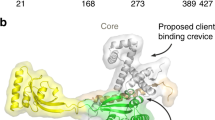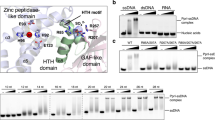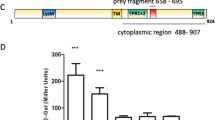Abstract
The PDZ domains of the trimeric DegS protease bind unassembled outer-membrane proteins (OMPs) that accumulate in the Escherichia coli periplasm. This cooperative binding reaction triggers a proteolytic cascade that activates a transcriptional stress response. To dissect the mechanism of allosteric activation, we generated hybrid DegS trimers with different numbers of PDZ domains and/or protease-domain mutations. By studying the chemical reactivity and enzymatic properties of these hybrids, we show that all subunits experience a strongly coupled energetic landscape. For example, OMP peptide binding to a single PDZ domain stimulates active site chemical modification and proteolytic cleavage in the attached and neighboring protease domains. OMP peptide binding relieves inhibitory PDZ interactions, whereas the interfaces between protease domains in the trimeric DegS core mediate positively cooperative activation driven by both substrate binding and inhibition relief.
This is a preview of subscription content, access via your institution
Access options
Subscribe to this journal
Receive 12 print issues and online access
$259.00 per year
only $21.58 per issue
Buy this article
- Purchase on Springer Link
- Instant access to full article PDF
Prices may be subject to local taxes which are calculated during checkout





Similar content being viewed by others
Change history
27 December 2012
In the version of this article initially published online, the title contained a spelling error: "through" was misspelled as "though." The error has been corrected for the PDF and HTML versions of the article.
References
Singh, N., Kuppili, R.R. & Bose, K. The structural basis of mode of activation and functional diversity: a case study with HtrA family of serine proteases. Arch. Biochem. Biophys. 516, 85–96 (2011).
Grau, S. et al. Implications of the serine protease HtrA1 in amyloid precursor protein processing. Proc. Natl. Acad. Sci. USA 102, 6021–6026 (2005).
Coleman, H.R., Chan, C.C., Ferris, F. & Chew, E.Y. Age-related macular degeneration. Lancet 372, 1835–1845 (2008).
Milner, J.M., Patel, A. & Rowan, A.D. Emerging roles of serine proteinases in tissue turnover in arthritis. Arthritis Rheum. 58, 3644–3656 (2008).
Vande Walle, L., Lamkanfi, M. & Vandenabeele, P. The mitochondrial serine protease HtrA2/Omi: an overview. Cell Death Differ. 15, 453–460 (2008).
Chien, J., Campioni, M., Shridhar, V. & Baldi, A. HtrA serine proteases as potential therapeutic targets in cancer. Curr. Cancer Drug Targets 9, 451–468 (2009).
Hara, K. et al. Association of HTRA1 mutations and familial ischemic cerebral small-vessel disease. N. Engl. J. Med. 360, 1729–1739 (2009).
Bowden, M.A. et al. High-temperature requirement factor A3 (Htra3): a novel serine protease and its potential role in ovarian function and ovarian cancers. Mol. Cell. Endocrinol. 327, 13–18 (2010).
Walsh, N.P., Alba, B.M., Bose, B., Gross, C.A. & Sauer, R.T. OMP peptide signals initiate the envelope-stress response by activating DegS protease via relief of inhibition mediated by its PDZ domain. Cell 113, 61–71 (2003).
Alba, B.M. & Gross, C.A. Regulation of the Escherichia coli σE-dependent envelope stress response. Mol. Microbiol. 52, 613–619 (2004).
Waller, P.R. & Sauer, R.T. Characterization of degQ and degS, Escherichia coli genes encoding homologs of the DegP protease. J. Bacteriol. 178, 1146–1153 (1996).
De Las Peñas, A., Connolly, L. & Gross, C.A. The σE-mediated response to extracytoplasmic stress in Escherichia coli is transduced by RseA and RseB, two negative regulators of σE. Mol. Microbiol. 24, 373–385 (1997).
Missiakas, D., Mayer, M.P., Lemaire, M., Georgopoulos, C. & Raina, S. Modulation of the Escherichia coli σE (RpoE) heat-shock transcription-factor activity by the RseA, RseB and RseC proteins. Mol. Microbiol. 24, 355–371 (1997).
Campbell, E.A. et al. Crystal structure of Escherichia coli σE with the cytoplasmic domain of its anti-σ RseA. Mol. Cell 11, 1067–1078 (2003).
Ades, S.E., Grigorova, I.L. & Gross, C.A. Regulation of the alternative σ factor σE during initiation, adaptation, and shutoff of the extracytoplasmic heat shock response in Escherichia coli. J. Bacteriol. 185, 2512–2519 (2003).
Kanehara, K., Ito, K. & Akiyama, Y. YaeL (EcfE) activates the σE pathway of stress response through a site-2 cleavage of anti-σE, RseA. Genes Dev. 16, 2147–2155 (2002).
Akiyama, Y., Kanehara, K. & Ito, K. RseP (YaeL), an Escherichia coli RIP protease, cleaves transmembrane sequences. EMBO J. 23, 4434–4442 (2004).
Li, X. et al. Cleavage of RseA by RseP requires a carboxyl-terminal hydrophobic amino acid following DegS cleavage. Proc. Natl. Acad. Sci. USA 106, 14837–14842 (2009).
Flynn, J.M., Levchenko, I., Sauer, R.T. & Baker, T.A. Modulating substrate choice: the SspB adaptor delivers a regulator of the extracytoplasmic-stress response to the AAA+ protease ClpXP for degradation. Genes Dev. 18, 2292–2301 (2004).
Chaba, R., Grigorova, I.L., Flynn, J.M., Baker, T.A. & Gross, C.A. Design principles of the proteolytic cascade governing the σE-mediated envelope stress response in Escherichia coli: keys to graded, buffered, and rapid signal transduction. Genes Dev. 21, 124–136 (2007).
Wilken, C., Kitzing, K., Kurzbauer, R., Ehrmann, M. & Clausen, T. Crystal structure of the DegS stress sensor: how a PDZ domain recognizes misfolded protein and activates a protease. Cell 117, 483–494 (2004).
Zeth, K. Structural analysis of DegS, a stress sensor of the bacterial periplasm. FEBS Lett. 569, 351–358 (2004).
Sohn, J., Grant, R.A. & Sauer, R.T. Allosteric activation of DegS, a stress sensor PDZ protease. Cell 131, 572–583 (2007).
Sohn, J., Grant, R.A. & Sauer, R.T. Allostery is an intrinsic property of the protease domain of DegS: implications for enzyme function and evolution. J. Biol. Chem. 285, 34039–34047 (2010).
Monod, J., Wyman, J. & Changeux, J.P. On the nature of allosteric transitions: a plausible model. J. Mol. Biol. 12, 88–118 (1965).
Sohn, J. & Sauer, R.T. OMP peptides modulate the activity of DegS protease by differential binding to active and inactive conformations. Mol. Cell 33, 64–74 (2009).
Sohn, J., Grant, R.A. & Sauer, R.T. OMP peptides activate the DegS stress-sensor protease by a relief of inhibition mechanism. Structure 17, 1411–1421 (2009).
Hasselblatt, H. et al. Regulation of the σE stress response by DegS: how the PDZ domain keeps the protease inactive in the resting state and allows integration of different OMP-derived stress signals upon folding stress. Genes Dev. 21, 2659–2670 (2007).
Cui, Q. & Karplus, M. Allostery and cooperativity revisited. Protein Sci. 17, 1295–1307 (2008).
del Sol, A., Tsai, C.J., Ma, B. & Nussinov, R. The origin of allosteric functional modulation: multiple pre-existing pathways. Structure 17, 1042–1050 (2009).
Liu, Y., Patricelli, M.P. & Cravatt, B.F. Activity-based protein profiling: the serine hydrolases. Proc. Natl. Acad. Sci. USA 96, 14694–14699 (1999).
Kimmel, J.L. & Reinhart, G.D. Isolation of an individual allosteric interaction in tetrameric phosphofructokinase from Bacillus stearothermophilus. Biochemistry 40, 11623–11629 (2001).
Schneider, F., Hammarström, P. & Kelly, J.W. Transthyretin slowly exchanges subunits under physiological conditions: a convenient chromatographic method to study subunit exchange in oligomeric proteins. Protein Sci. 10, 1606–1613 (2001).
Clausen, T., Kaiser, M., Huber, R. & Ehrmann, M. HTRA proteases: regulated proteolysis in protein quality control. Nat. Rev. Mol. Cell Biol. 12, 152–162 (2011).
Creighton, T.E. Proteins, Structures and Molecular Properties 2nd edn. (WH Freeman & Co., New York, 1993).
Eigen, M. Kinetics of reaction control and information transfer in enzymes and nucleic acids. Nobel Symp. 5, 333–369 (1967).
Hammes, G.G. & Wu, C.W. Regulation of enzyme activity. The activity of enzymes can be controlled by a multiplicity of conformational equilibria. Science 172, 1205–1211 (1971).
Hagan, C.L., Silhavy, T.J. & Kahne, D. β-Barrel membrane protein assembly by the Bam complex. Annu. Rev. Biochem. 80, 189–210 (2011).
Acknowledgements
This work was supported by US National Institutes of Health (NIH) grant AI-16892 (R.T.S.). R.V.M. was supported by an NIH postdoctoral fellowship (GM097972). We thank B. Stinson, A. Olivares, J. Sohn, A. Nager, A. de Regt and S. Kim for helpful discussions.
Author information
Authors and Affiliations
Contributions
R.V.M. performed all experiments. R.V.M. and R.T.S. contributed to experimental design, interpretation and writing of the manuscript.
Corresponding author
Ethics declarations
Competing interests
The authors declare no competing financial interests.
Supplementary information
Supplementary Text and Figures
Supplementary Results (PDF 1334 kb)
Rights and permissions
About this article
Cite this article
Mauldin, R., Sauer, R. Allosteric regulation of DegS protease subunits through a shared energy landscape. Nat Chem Biol 9, 90–96 (2013). https://doi.org/10.1038/nchembio.1135
Received:
Accepted:
Published:
Issue Date:
DOI: https://doi.org/10.1038/nchembio.1135
This article is cited by
-
HtrA1 activation is driven by an allosteric mechanism of inter-monomer communication
Scientific Reports (2017)
-
Light-based electrophysiology
Nature Methods (2012)



